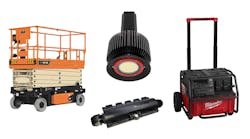Changes in office design over the past 30 years are a mere shadow of what these workspaces will look like in the future. Back then, several trends in the design of commercial office space emerged. The building envelope was sealed tight to save energy (no operable windows), and interior walls disappeared in favor of the cubicle, which proliferated into an open office concept. Soon afterward, computers started to appear on desktops — and things have only evolved from there.
What does the future hold? The tablet PC and the smartphone, with their inherent versatility and swift access to Internet-based “cloud” services, will inevitably alter the way business information is generated and exchanged. Office networks will be supporting both live streaming video as well as financial and health care transactions. Telecommuting, virtual project teams, and communications across time zones will call for the simultaneous contribution of many staffers.
Consider this scenario: As workers gather for a meeting in a conference room, flat screen message boards and elaborate projection systems deliver images on dividers, walls, and even conference tables, so that any vertical or horizontal plane can be used as a viewing screen. One big challenge surrounding this scene is the lighting system is expected to adapt to these changing visual tasks at a moment’s notice.
Tomorrow’s offices will feature areas for staff collaboration and interaction. The idea is to break down the typical barriers of office design and provide spaces that are more comfortable, less static, and hierarchical. Research institutions discovered long ago that the most important work often gets done in the “in-between” spaces, such as a lounge or break room.
Looking ahead, we may also see designers of office lighting systems using the term “health per watt” instead of “lumens per watt” as a way of recognizing the health-related aspects of lighting for office workers. Dr. Joan Roberts, Chair of the Department of Natural Sciences, Fordham University, notes that new research indicates we do not know as much as we thought about light and lighting. Studies indicate that the circadian system is not a one-size-fits-all proposition. People need different amounts of light at different times of the day for various durations of time in their work. Thus, the rise of green legislation and light/health discoveries will help determine the lighting products of the future that get specified for workspaces. For these reasons, we will see less general lighting and more purposeful task lighting, suited to each worker’s personal preferences.
Energy codes, such as ASHRAE Standard 90.1 – Energy Standard for Buildings Except Low-Rise Residential Buildings and the ASHRAE Standard 189.1 – Standard for the Design of High-Performance, Green Buildings, are two important reasons why high-efficiency lighting fixtures and integrated controls will be mandated. In addition, the next-generation standards will want to know where and for how long the lighting is in use — not just the watts per square foot in the design.
In summary, electrical contractors can prepare for these new concepts by developing an understanding of basic sensing and control technologies and the communications systems that will support tomorrow’s lighting systems.
Improving the Old
Linear fluorescent lamp and ballast manufacturers continue to improve the efficiency of “older technology” light sources, and they will continue to be specified for some time. Look for important new concepts, such as parallel lamp operation for programmed-start electronic ballasts, RoHS-compliant lamps and ballasts, T8 instant-start ballasts with a 1.0 ballast factor, 4-lamp T5 programmed-start ballasts, DALI ballast for T5 lamps, and new dimming and light level switching ballasts. Applying some of these products can reduce the number of luminaires required for an office project by at least 10%.
Manufacturers will generally be settling on two types of control systems for general office lighting: the analog 0V to 10VDC system (useful for conference rooms and similar spaces) and a digital control network (suitable for building-wide application).
Although digital lighting systems have been available for a number of years, it has taken all this time for the technology to become good enough, small enough, cheap enough, and powerful enough to embed a full-featured microprocessor and network interface into a wall switch or a luminaire. It also took something else — ease of installation.
The most popular protocol for a digital lighting control system will be some form of the Digital Addressable Lighting Interface (DALI) design, which uses a simple, 2-wire bus circuit to connect sensors, ballasts, and input ports. Programming is stored throughout the circuit’s devices. Although each bus is limited to 64 nodes, you can use multiple buses. The control components are relatively simple to install, and you can move the devices with considerable ease. However, up to this point, commissioning the system has been an expensive and time-consuming task. Nevertheless, manufacturers are working to simplify this effort.
Most end-users, recognizing the value proposition for light-emitting diodes (LEDs), will be requesting this light source despite the higher initial cost of solid-state lighting. Why? The LED source is inherently controllable, the color of the light can be modified, it uses no mercury, and it foregoes the limitations of all the traditional light sources.
Rethinking the Ceiling Plane
New design possibilities for the sensing and control of lighting, unrestricted by the traditional grid ceiling, are being studied and considered as well in an effort to picture the office of the future. Here is one concept: Today’s office is packed with a variety of electronic digital devices. Services, such as environmental sensors, HVAC actuators, motors for window shades, signage, security system elements, and A/V systems, also assist in making the office useful and comfortable. Because these devices are usually low-voltage DC operated — and delivering this DC electric power system requires a number of transformations and rectifications from the AC electrical power distribution system — electrical energy is consumed (wasted) at each conversion point.
So, in addition to the AC electric power system, it might be practical to have a dedicated DC electric power distribution system available to serve the electronic equipment and avoid all of the power transformations. With that idea, a number of companies — energy service and building product firms as well as many lighting and lighting control vendors — formed the EMerge Alliance in 2008 to create a practical DC power delivery method for tomorrow’s buildings. Less than two years later, the Alliance completed its 24VDC Occupied Space standard for the office interior, which calls for using a 24VDC power distribution system for the electronic equipment. It has since registered dozens of products that support this Emerge Alliance standard.
Another important consideration is that LEDs and organic LEDs (OLED), which are usually served at 12VDC or 24VDC, will most likely be the dominant light source of the future for any Emerge Alliance-type projects. LED luminaries would typically be smaller and lighter than standard fluorescent ceiling luminaires, easier to install, and easier to reconfigure without incurring a complete rewiring project.
The EMerge system design has provision for a wireless receiver within each luminaire. The addressable fixtures could be controlled via a wireless battery-less switch, occupancy sensor, or a wireless system that uses batteries.
Computers andLighting Merge
Another design concept blurs the lines between lighting systems and IT communications systems, using a completely disruptive approach. This lighting control system recognizes that any network or system-based control technique to measure or optimize light has to be added as an overlay to the AC power system. That is, another low-voltage wiring scheme must be installed to implement adequate energy-saving strategies.
In this case, a chassis, containing a power supply and controller (LED driver) for up to 64 fixtures, collects information from sensors and controls to determine the light level for each fixture. The central controller unit can further be connected to a data network and other controllers for expanded capacity.
A single pair of conductors (a Class 2 cabling system) carries both the constant current DC power for a single fixture and a proprietary communication network, which provides sensing and control for the lighting equipment.
A cylindrical module containing a number of sensors is mounted next to each luminaire in the ceiling. Also called an adapter, the module (about 1 inch in diameter and 3 inches long) connects the luminaire to the DC power supply and also to the data network. The sensor array detects voltage, current, light level, and motion, along with LED and room temperature. Additional sensors (e.g. carbon monoxide, air quality, and light color measurement) can be added at negligible cost.
Because every luminaire in the lighting network is essentially a data gathering point — and given the fact that luminaires are usually set in a grid pattern in the ceiling plane — the system has a Web-based software program that can display the power usage, occupancy, and temperature in a room or an open plan area. Typically, there might be 3,000 to 6,000 data connections in a 250,000-square-foot building. This lighting control system could add about 12,000 more connections.
For identification, each fixture has a radio frequency identification (RFID) tag and also includes either a matching hardwired ID chip or an RFID reader capable of reading the RFID tag. The tags allow for rapidly commissioning the lighting system.
Although there is some resemblance, this lighting system differs from the Power-over-Ethernet (PoE) standard, which carries DC power on one or two twisted pair in a data network cable and uses a voltage-driven architecture. This lighting system uses a current-driven architecture. The network protocol is simple, offers a low cost, and features appropriate latency and adequate bandwidth for the application. The control strategies handled by this lighting system include:
- Scheduling. Turns off or dims lighting systems automatically at predetermined times for various locations throughout the office building during workdays, evenings, and weekends. If a building has a regular pattern of use, the system can be used to control other systems (HVAC) based on that occupancy.
- Occupancy sensors. The presence or absence of persons in a space is determined. In addition to the general lighting, task lighting and plug loads can also be controlled.
- Dimming and task tuning. The light level is based on occupant requirement in the space and the preference of the user.
- Daylight harvesting. Large windows or skylights can capture sunlight and naturally illuminate the space. The system responds to changing ambient light levels throughout the day, allowing electric lighting to be reduced.
- Visibility and reporting. The operation status, the efficiency, and the installation date of each fixture is retained.
- Lumen depreciation and fault management. All light levels are recorded along with the AC and DC voltage.
- Load shedding for demand response. The system reduces the building’s lighting load in response to utility rate changes, pricing signals, or incentives by automatically or dynamically changing lighting use.




